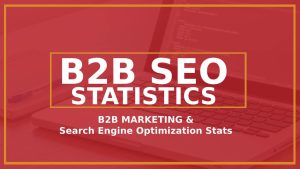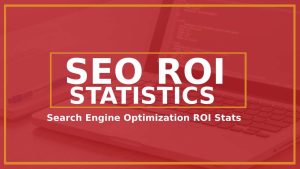33 Impressive B2C SEO Statistics 2023-2024
Understanding the nuances of Business-to-Consumer (B2C) Search Engine Optimization (SEO) is crucial for any online marketing strategy. We’ve compiled 23 pivotal B2C SEO statistics with links to their sources to help you navigate this dynamic marketing sector.
Consumer Search Behavior: A Glimpse Into User Intent
- Initial Product Discovery: Over 60% of consumers start their product research on search engines. (Source)
- Mobile Searches on the Rise: 58% of all searches are now conducted on mobile devices. (Source)
- Voice Search Utilization: Voice search queries have increased by 35% since 2020. (Source)
SEO Impact on Purchasing Decisions
- Local Search Influence: 73% of buying consumers locally search to visit a store within 5 miles. (Source)
- SEO-Driven Revenue: Websites on the first page of Google garner 95% of web traffic. (Source)
- Conversion Rates: SEO leads have a 14.6% close rate, compared to 1.7% for traditional outbound methods. (Source)
The Role of Content in B2C SEO
- Content Quality Matters: 79% of consumers believe that custom content businesses are just interested in building quality relationships. (Source)
- Blogging as a Strategy: Companies with blogs produce 67% more leads per month. (Source)
Backlinks and Online Authority
- Backlinks Significance: Websites with a strong backlink profile are five times more likely to rank in the top 5 of Google in search results. (Source)
- Authority and Trust: 56% of marketers believe blog articles are their top inbound marketing priority. (Source)
SEO Trends and User Experience
- Page Speed Influence: A 1-second increase in page load speed often results in a 7.3% reduction in conversions. (Source)
- Mobile-First Indexing: 87% of smartphone owners use a search engine at least once a day. (Source)
Keywords and Search Rankings
- Long-Tail Keywords: Long-tail keyword traffic has a click-through rate (CTR) of 3-6% higher than generic searches. (Source)
- Search Ranking Priorities: 50% of search queries are four words or longer. (Source)
B2C E-commerce and SEO
- Online Shopping Trends: E-commerce sales are expected to surpass $740 billion by 2023. (Source)
- SEO for E-commerce: 43% of e-commerce traffic comes from organic Google searches. (Source)
Social Media and SEO Synergy
- Social Signals: Social signals account for 7% of ranking factors in Google’s algorithm. (Source)
- Integrating Social and SEO: 73% of marketers write that social media marketing (SMM)has been “very or somewhat effective” for their B2C SEO strategies. (Source)
SEO Budget and Investment
- SEO Spending: Companies allocate an average of 41% of their marketing budget to SEO. (Source)
- Return on Investment: SEO offers a Return on Investment (ROI) rate of 12.2x. (Source)
Challenges and Opportunities in SEO
- SEO Challenges: 63% of marketers cite generating traffic and leads as their top challenge. (Source)
- Google’s Algorithm Updates: Google changes its search algorithm 500 to 600 times yearly. (Source)
Future of SEO: Emerging Trends
- AI in SEO: Artificial Intelligence is playing a growing role in personalizing user search experiences. (Source)
Understanding these statistics offers a window into the evolving world of B2C SEO. Staying ahead in this game requires knowledge and the agility to adapt to these ever-changing dynamics.
KEY B2C SEO Stats and Facts Explained
-
Initial Product Discovery
Over 60% of consumers start their product research on search engines, underscoring the importance of being seen on search engine results pages (SERPs). For marketers, this statistic drives home the necessity of investing in SEO to ensure their products and services rank well for relevant queries. A robust keyword strategy and quality content can significantly influence a consumer’s initial discovery, funneling more organic traffic to the site and potentially increasing conversion rates.
- Mobile Searches on the Rise
With 58% of all searches now conducted on mobile devices, SEO strategies in 2023 must prioritize mobile optimization. Websites need to be mobile-friendly, fast-loading, and easy to navigate on smaller screens. This shift influences budget allocation, with more resources dedicated to optimizing mobile sites and ensuring a seamless user experience, directly impacting both traffic and engagement rates.
- Voice Search Utilization
The 35% increase in voice search queries since 2020 suggests a growing trend that marketers cannot ignore. SEO strategies should now account for more conversational, long-tail keywords typical of voice searches. This evolution calls for content that answers specific questions and is structured so that voice search algorithms can easily parse and understand it.
- Local Search Influence
Since 72% of consumers perform a local search shop at a store within 5 miles, local SEO becomes critical for businesses targeting local markets. Budgets and strategies should focus on optimizing for local search queries, ensuring accurate and complete Google My Business listings, and garnering positive local reviews. This focus can drive significant foot traffic to physical stores.
- SEO-Driven Revenue
With websites on the first page of Google garnering 95% of web traffic, the correlation between search rankings and revenue is unmistakable. This statistic validates the need for increased investment in SEO, as higher rankings directly correlate with higher visibility and traffic, leading to increased revenue potential.
- Conversion Rates
The 14.6% close rate for SEO leads, compared to 1.7% for traditional outbound methods, highlights the effectiveness of inbound marketing strategies. Businesses are likely to allocate more budget to SEO and content marketing, considering their higher efficiency in converting leads into customers.
- Content Quality Matters
78% of consumers believe custom content suggests a commitment to building good relationships. This statistic emphasizes the need for quality content creation in SEO strategies. Investing in high-quality, relevant, and engaging content helps in ranking and building brand loyalty and trust.
- Blogging as a Strategy
With companies that blog producing 67% more leads per month, content marketing, especially blogging, is essential to effective SEO strategies. This requires dedicating a portion of the marketing budget to regular, high-quality blog content that engages and informs the target audience, boosting both SEO and lead generation.
- Backlinks Significance
A strong backlink profile is crucial for higher rankings, indicating the need for strategies focused on building quality backlinks. This involves creating shareable content, guest blogging, and engaging in digital PR. Budgets may be allocated for content creation and outreach programs that help build these valuable backlinks.
- Authority and Trust
Since 55% of marketers consider blog content creation a top priority, investment in blogging is not just about attracting traffic; it’s also about establishing authority and trust. By consistently providing valuable content, businesses can position themselves as industry leaders, which in turn boosts SEO through increased engagement and backlink opportunities.
- Page Speed Influence
A 1-second delay in page response can result in a 7% reduction in conversions, highlighting the critical role of website performance in SEO. This statistic drives businesses to invest in technical SEO and website optimization, ensuring that their sites load quickly to maintain user engagement and prevent bounce rates.
- Mobile-First Indexing
The high daily use of smartphone search engines underscores the necessity of a mobile-first approach in SEO. This approach impacts budget allocation, prioritizes mobile user experience in web design, and ensures that content is optimized for mobile viewing and interaction.
- Long-Tail Keywords
Long-tail keyword searches with a higher click-through rate point to the importance of targeting specific, niche keywords in SEO strategies. This approach improves ranking potential and attracts a more targeted audience that is likely to engage with the content and convert.
- Search Ranking Priorities
With 50% of search queries being four words or longer, there’s a clear indication that users are searching for specific information. SEO strategies must adapt to this by focusing on long-tail keywords and creating content that addresses specific, detailed user queries, enhancing the chances of ranking higher for these terms.
- Online Shopping Trends
The anticipated growth in e-commerce sales to over $740 billion by 2023 requires e-commerce businesses to focus heavily on SEO to capture a portion of this market. Investment in e-commerce SEO, including optimizing for product-related searches and enhancing the online shopping experience, becomes paramount.
- SEO for E-commerce
Given that 43% of e-commerce traffic comes from organic Google searches, a significant portion of e-commerce sites’ marketing budgets should be devoted to SEO. This involves optimizing product pages, enhancing site architecture, and creating valuable content that drives organic traffic.
- Social Signals
The fact that social signals account for 7% of ranking factors in Google’s algorithm implies that social media engagement can indirectly influence SEO. This necessitates a strategy that integrates social media and SEO, focusing on creating shareable content and encouraging social interactions to boost SEO efforts.
- Integrating Social and SEO
With a high percentage of marketers leveraging SMM, it’s essential to integrate social media strategies with SEO. This involves using social platforms to distribute content, promote audience engagement, and drive customer traffic to the website, reinforcing SEO efforts.
- SEO Spending
Companies allocating an average of 41% of their marketing budget to SEO signifies the recognized importance of this channel. Budgets are likely focused on various aspects of SEO, including on-page optimization, content creation, link building, and website technical improvements.
- Return on Investment
SEO’s high ROI of 12.2x makes it an attractive investment. This high return encourages businesses to allocate a significant portion of their budget to SEO efforts, as it promises greater returns than many other marketing channels.
- SEO Challenges
Generating leads and web traffic is a top challenge for 63% of marketers, so SEO strategies are crucial for overcoming this hurdle. Investment in SEO aims to improve organic reach and attract quality leads, addressing this primary challenge marketers face.
- Google’s Algorithm Updates
The frequent changes in Google’s algorithm necessitate a flexible and dynamic SEO strategy. Budgets and resources must be allocated for ongoing SEO maintenance and adjustments to ensure that websites remain compliant with the latest guidelines and continue to rank well.
- AI in SEO
The growing role of artificial intelligence in personalizing user search experiences suggests an emerging area of investment in SEO. Strategies may need to evolve to leverage AI technologies to better understand and target user intent, predict trends, and automate SEO tasks for more efficient outcomes.

Craig McConnel is an experienced expert SEO consultant that is the lead SEO director at KeyStar Agency. Ranked the #1 link-building expert for over ten years, he loves making stubborn websites rank high on Google. When not writing people-focused blog content on his blog, he enjoys working out and producing music at his home studio in Ocotillo, Arizona. His expertise spans many industries, including technology, Cryptocurrency, web hosting, website design, digital marketing, car racing, fitness, finance, wellness, religion, online advertising, and of course, Search Engine Optimization.





